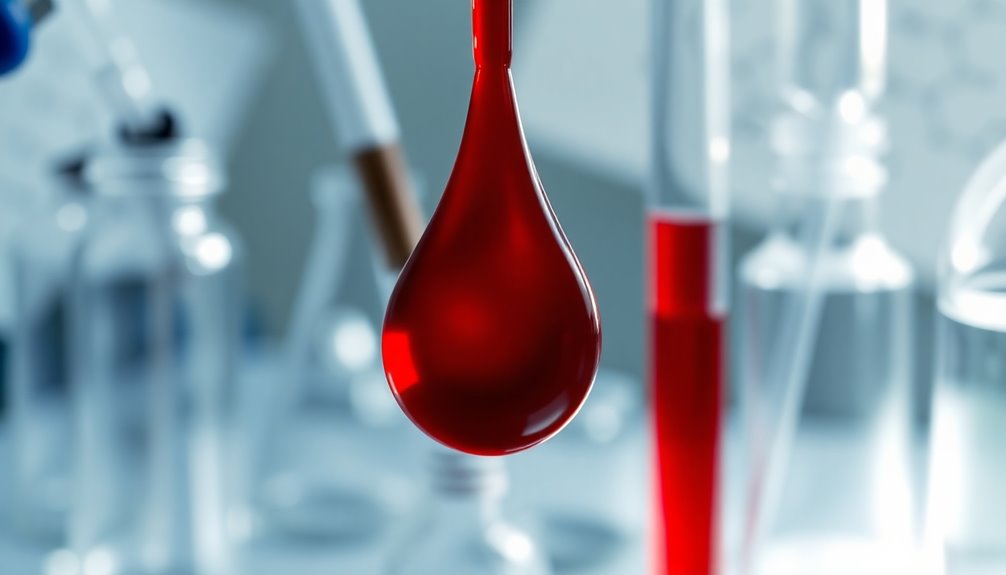Menstrual blood comes from the shedding of the uterine lining when pregnancy doesn't happen. Each month, your body prepares for a potential pregnancy by thickening this lining. If an egg isn't fertilized, hormones drop, and the body sheds this lining, resulting in menstrual blood. It's a natural process, but many myths surround it. Want to discover more about menstrual blood, its composition, and what it reveals about your health? There's plenty to learn!
Key Takeaways
- Menstrual blood originates from the shedding of the uterine lining when fertilization does not occur after ovulation.
- It consists of a mix of blood, uterine tissue, and vaginal fluids.
- The color of menstrual blood can vary, indicating different stages of the menstrual cycle.
- Hormonal changes throughout the cycle regulate the preparation and shedding of the uterine lining.
- Menstrual blood is often misunderstood; it is not dirty but has diagnostic value for reproductive health.
The Menstrual Cycle Explained

Understanding the menstrual cycle is essential, as it plays a crucial role in reproductive health.
The menstrual cycle typically lasts about 28 days, but it can vary between 21 to 35 days for you. Throughout this cycle, hormonal changes prepare your body for a potential pregnancy by thickening the uterine lining.
The menstrual cycle averages 28 days, varying from 21 to 35 days, with hormonal shifts preparing the body for pregnancy.
If fertilization doesn't occur, your body sheds this lining, resulting in menstrual blood, which usually lasts around 5 days.
Ovulation, when an egg is released from your ovaries, takes place roughly midway through the cycle, around day 14 for a 28-day cycle.
If you're experiencing irregular cycles, remember that it's common in the first few years after menarche, with regularity often developing within 2-3 years.
The Role of Hormones in Menstruation

Hormones are the driving force behind the menstrual cycle, influencing everything from the growth of the uterine lining to the onset of menstruation.
Estrogen levels rise during the first half of your menstrual cycle, thickening the uterine lining in preparation for a potential pregnancy. After ovulation, progesterone kicks in, ensuring the lining remains intact for a fertilized egg.
If fertilization doesn't happen, progesterone levels drop, triggering the breakdown of the uterine lining. This leads to your period, typically around 14 days after ovulation.
Although the average menstrual cycle lasts about 28 days, hormonal fluctuations can cause variations in cycle length and menstrual symptoms, making each experience unique.
Understanding this hormonal dance helps you better comprehend your menstrual cycle.
Understanding Menstrual Blood Composition

Menstrual blood isn't just blood; it's a complex mixture of uterine lining, blood, and vaginal fluids.
You might notice variations in its composition, including color and the presence of clots, which can indicate different stages of your cycle.
Understanding these components can give you insight into your overall reproductive health.
Components of Menstrual Blood
The intricate composition of menstrual blood reveals much about your body's reproductive health.
Menstrual fluid, often referred to as menstrual effluent, consists of discarded uterine lining, blood, vaginal fluid, and various cells and proteins. During your cycle, you typically shed about 30 to 80 milliliters of this fluid.
The color of normal menstrual blood can range from bright red to dark brown, influenced by the cycle's stage and blood age. You might notice thick clumps or stringy blood, which often result from blood clots and a high concentration of uterine lining.
Each individual's menstrual blood carries a unique physiological fingerprint, potentially offering insights into various health conditions, especially during periods that last longer than usual.
Variability in Blood Composition
Understanding how menstrual blood varies can shed light on your overall reproductive health.
Menstrual blood, or menstrual effluent, isn't just blood; it's a complex mix of endometrial tissue, cells, proteins, and mucus from your uterine lining.
Throughout your cycle, you might notice differences in consistency. For instance, stringy or clumpy blood often suggests the presence of uterine lining or blood clots.
On heavy flow days, the blood can appear darker or gel-like due to a higher concentration of endometrial tissue.
These variations can serve as unique physiological fingerprints, potentially indicating underlying health conditions.
Increasing research highlights the diagnostic value of menstrual blood, particularly in identifying issues like endometriosis through the presence of specific endometrial cells.
Common Myths About Menstrual Blood

You might've heard various myths about menstrual blood that can create confusion.
Many people mistakenly think it's just dirty blood or that all menstrual flow is the same.
Let's clear up these misconceptions and explore the real facts about menstrual blood composition, clots, and health implications.
Menstrual Blood Composition Misconceptions
While many people hold misconceptions about menstrual blood, it's essential to recognize its true nature and composition. Menstrual blood isn't "dirty" or toxic; it's a healthy part of life and reflects your reproductive health.
Here are some common myths debunked:
- Menstrual blood is just blood.
- It's a contaminated fluid.
- The color indicates health issues.
- Menstrual blood has no diagnostic value.
- It's the same for everyone.
In reality, menstrual blood consists of blood, cervical mucus, vaginal secretions, and the shed lining of the uterus.
Its color and consistency vary due to factors like flow rate and oxygen exposure. Understanding these facts can help eliminate stigma and promote a better grasp of your body's natural processes.
Clots vs. Normal Flow
Many people mistakenly equate menstrual clots with a sign of trouble, but they're often a normal part of the menstrual flow. During your period, it's common to see clumpy or stringy period blood, especially on heavy bleeding days. Small clots, about the size of a quarter, can pass without concern. However, if you notice prolonged changes or excessive bleeding, it's wise to consult your healthcare provider.
| Type of Blood | Description | When It Occurs |
|---|---|---|
| Small Clots | Normal, about quarter-sized | Any time during the period |
| Stringy Blood | Caused by high uterine lining | Heavy flow days |
| Clumpy Blood | Jelly-like, varies in color | Throughout the menstrual cycle |
Impurities and Health Myths
Understanding menstrual blood involves more than just recognizing its physical characteristics; it also requires addressing the myths and misconceptions that surround it. Many cultural stigmas label menstrual blood as impure or dirty, but that's far from the truth.
Here are some common health myths about menstrual blood:
- It contains harmful toxins.
- Menstrual blood is "dirty" or impure.
- There are such things as "menotoxins."
- It's less studied than other bodily fluids.
- Menstruating women should be isolated.
Research shows that menstrual blood is a natural biological fluid made up of uterine lining, blood, and vaginal fluid.
Open discussions and education can help you dispel these myths and promote a better understanding of menstruation.
The Importance of Menstrual Blood in Medical Research

As researchers explore the complexities of menstrual blood, they uncover its potential as a valuable tool in medical diagnostics. This fluid is more than just a monthly occurrence; it offers insights into your health.
Recent studies indicate that analyzing menstrual blood can aid in diagnosing conditions like endometriosis without invasive procedures. The unique composition of menstrual fluid, including endometrial cells, varies in individuals with endometriosis, which could lead to quicker and less painful diagnoses.
By examining the components of menstrual blood, researchers aim to develop non-invasive diagnostic methods that enhance understanding of immune system communication and inflammation.
Ultimately, recognizing the significance of menstrual blood could revolutionize women's health research and improve healthcare outcomes for various gynecological conditions.
Breaking the Stigma Surrounding Menstruation

Though menstruation is a natural biological process, it has long been shrouded in stigma and misunderstanding.
Menstruation is a natural process, yet it remains clouded by stigma and misunderstanding that must be addressed.
It's vital to break this cycle of silence and shame, especially when 26% of the global population are women of reproductive age.
Here are some key points to reflect upon:
- Menstruation isn't impure or shameful.
- Education helps dispel myths and misconceptions.
- Awareness can reduce physical health risks.
- Conditions like endometriosis need open discussions.
- Your experience with your first period is valid.
Frequently Asked Questions
Where Does the Period Blood Come Out From?
Period blood comes out through the vagina.
During your menstrual cycle, the uterus sheds its lining, which includes blood, cervical mucus, and vaginal fluid. This process typically lasts between 3 to 7 days, with the heaviest flow occurring in the first couple of days.
You can expect to lose about 30 to 80 milliliters of blood during this time, with the color and consistency changing throughout your period.
Where Does Period Blood Come From Pee?
You might think period blood comes from urine, but that's a common misconception.
While urine's produced by your kidneys, period blood originates from the uterus. Each month, your body builds up a lining in preparation for a possible pregnancy.
If that doesn't happen, the lining, along with blood and vaginal fluids, is shed as menstrual blood.
Does Period Blood Come From the Fallopian Tubes?
No, period blood doesn't come from the fallopian tubes.
Instead, it originates from the uterine lining, which thickens each month in preparation for a potential pregnancy. If an egg isn't fertilized, this lining breaks down, leading to menstruation.
The blood and tissue exit your body through the cervix and vagina, making up what you experience during your period.
Understanding this can help you feel more comfortable discussing menstruation openly.
Where Do Period Blood Clots Come From?
You might wonder where period blood clots come from, how they form, and what they mean for your menstrual health.
These clots typically form when your menstrual flow mixes with blood, uterine lining, and vaginal fluid.
During heavier flow days, you may notice small clots, while stringy ones often occur early in your cycle.
While clots can be normal, keep an eye on their size and frequency, as changes may need a doctor's attention.
Conclusion
To conclude, understanding where menstrual blood comes from helps demystify the menstrual cycle and empowers you. Did you know that about 80% of women experience some form of menstrual discomfort, yet many feel isolated in their experiences? By breaking the stigma surrounding menstruation, we can foster a more supportive environment for all. Embracing open conversations about menstruation not only enhances awareness but also promotes better health and understanding within our communities.









